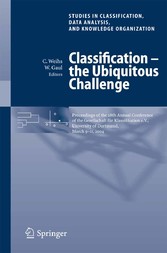Search and Find
Service
More of the content

Classification - the Ubiquitous Challenge - Proceedings of the 28th Annual Conference of the Gesellschaft für Klassifikation e.V., University of Dortmund, March 9-11, 2004
Quantitative Assessment of the Responsibility for the Disease Load in a Population (p. 109-110)
Wolfgang Uter and Olaf Gefeller
Department of Medical Informatics, Biometry and Epidemiology,
University of Erlangen Nuremberg, Germany
Abstract. The concept of attributable risk (AR), introduced more than 50 years ago, quantifies the proportion of cases diseased due to a certain exposure (risk) factor. While valid approaches to the estimation of crude or adjusted AR exist, a problem remains concerning the attribution of AR to each of a set of several exposure factors. Inspired by mathematical game theory, namely, the axioms of fairness and the Shapley value, introduced by Shapley in 1953, the concept of partial AR has been developed. The partial AR offers a unique solution for allocating shares of AR to a number of exposure factors of interest, as illustrated by data from the German G¨ottingen Risk, Incidence, and Prevalence Study (G.R.I.P.S.).
1 Introduction
Analytical epidemiological studies aim at providing quantitative information on the association between a certain exposure, or several exposures, and some disease outcome of interest. Usually, the disease etiology under study is multifactorial, so that several exposure factors have to be considered simultaneously. The effect of a particular exposure factor on the dichotomous disease variable is quantified by some measure of association, including the relative risk (RR) or the odds ratio (OR), which will be explained in the next section.
While these measures indicate by which factor the disease risk increases if a certain exposure factor is present in an individual, the concept of attributable risk (AR) addresses the impact of an exposure on the overall disease load in the population. This paper focusses on the AR, which can be informally introduced as the answer to the question, "what proportion of the observed cases of disease in the study population suffers from the disease due to the exposure of interest?". In providing this information the AR places the concept of RR commonly used in epidemiology in a public health perspective, namely by providing an answer also to the reciprocal question, "what proportion of cases of disease could - theoretically - be prevented if the exposure factor could be entirely removed by some adequate preventive action?". Since its introduction in 1953 (Levin (1953)), the concept of AR is increasingly being used by epidemiological researchers.
However, while the One of the diffculties in applying the concept of AR is the question of how to adequately estimate the AR associated with several exposure factors of interest, and not just one single exposure factor. The present paper briefly introduces the concept of sequential attributable risk (SAR) and then focusses on the partial attributable risk (PAR), following an axiomatic approach founded on game theory. For illustrative purposes, data from a German cohort study on risk factors for myocardial infarction are used. methodology of this invaluable epidemiological measure has constantly been extended to cover a variety of epidemiological situations, its practical use has not followed these advances satisfactorily (reviewed by Uter and Pfahlberg (1999)).
All prices incl. VAT












